Handicrafts and heritage in Nubia: –

On the Nubian tones, the Nubian women and men still continue to work in the manufacture of handicrafts, and the memory takes them back to the ancient Nubia, where the ancestors practiced this craft in the houses overlooking the Nile directly south of Aswan, and it has now become a legacy for generations.
The crafts and handicrafts that the Nuba people work in Aswan, and they were able, through the legacy of the ancestors, to reach the world in their products that relied on the environment and handicrafts without the intervention of machines or factory machines, until they made shapes and figures of different colors and sizes from them, and the exhibits of the Nubian people became necessary supplies for the tourist And the visitor inside the Nubian villages in Aswan.
The Nubian handicrafts shows the handicrafts inherited from the ancestors, “which is the manufacture of handicrafts that are reused from nature and the surrounding environment, such as palm trees, trees, stones, etc., and women in the past made these products for the purpose of using them in homes and not marketing them as is the case now.”
Also, among these products are “Al Waleel”, “Kreij”, and “Al Fattah”, which are Nubian names for some products. “Al-Waleel” is the cover for the eating tray, and it is one of the heritage found inside every home. It is made of palm leaves and woolen threads, and it features with different bright colors. And there are sizes in it and it must be hung on the walls of every house, stressing that the Nubian groom must paint this shape on the walls of his house himself using oil paints, and this waleel is used to put cups on it and cover food trays.
Also, Nubian handmade products have become a prominent sign for the people of Nuba and draw the attention of visiting tourists after most of the Nubian villages have turned into tourist attractions, where foreign tourists prefer to visit to enjoy a clean environment free of noise and industrial pollutants, as they are environmental villages that overlook the Nile directly and there are houses built in the old style For the brightly colored Nubia, and its people live on the ancient customs and traditions that they inherited from their ancestors.
There are many local exhibitions inside Egypt as well as international ones in handicrafts, as each craft depends on all palm derivatives without external interference for any part of the piece that it manufactures, and although the materials that are relied upon are of no value to farmers and most of them get rid of them except for their dependence on palm leaves Palm trees only, but these raw materials are used by recycling them, at a time when they get rid of:
For its part, the Aswan governorate was keen to establish and organize an open exhibition of handicrafts for Nubian and Aswan women, in which about 30 women participated, displaying distinctive heritage products of a Nubian character known for its shapes and colors, whether in relation to wicker, thread, or beads such as shawls, caps, necklaces, etc., and it is frequented by many Egyptian visitors and foreign tourists, as it is one of the distinctive tourist attractions in Aswan, and many of them are keen to buy and acquire some gifts and purchases that features Aswan, such as Nubian handicrafts, hibiscus, dates, doum, salted fish, and other distinctive things that features Aswan.
wicker industry:
The wicker industry is one of the handicrafts that Nuba is famous for. It consists of palm leaves that are braided with each other in a way that narrows or widens according to the quality of the product. Wicker crafts are often done by women, and bright colors are placed on them to add an aesthetic look to them, and this profession is transmitted by inheritance Where the mother is keen to teach her daughter the basics of the craft, and in some societies men share with women, especially in the manufacture of large baskets
The wicker is divided into two types:
The first kind
It’s the core of wicker (which is located inside the palm tree), and it is features with its bright whiteness, small size, and ease of formation. It is often used in making small baskets and fine artifacts. It is features with its spatial decoration, the use of more than one color in the same product, and the distribution of colors in aesthetic engineering systems.
The second kind
It consists of the rest of the regular palm leaves, which are coarser and longer leaves. They are immersed in water to soften them so that they can be easily braided and shaped. It is used to manufacture mats, large baskets, and pickets that are often used for agricultural purposes (collecting crops, carrying hay, backfilling) or using them for shopping, as they can accommodate many purchases in addition to being easy to carry Above the head of the crop and grain sellers, whereas they display their goods, and large decorative units are used on these products, and often colors are not used with them, but they may be inlaid in some products, white wicker braided with green
Wicker products work to preserve foods and grains and not expose them to damage or rot due to their resistance to moisture.
Various types of baskets are made from the wicker of the palm tree, which are used as containers for preserving the needs of the house, presenting food and baked goods, carrying vegetables, displaying grains and yields to apothecaries and grain sellers, mats, floor mats (perches) and prayer rugs in their various shapes: oval, rectangular, fans, and headbands.
How to dye wicker:
The wicker is dyed in different colors available at the spice shops. The dyeing usually begins with boiling water in a large pot and the required dye is placed in it. Then the wicker to be colored is dropped and left for 5 minutes, then removed from the water and placed in the shade to dry.
As for the white or milky wicker, it acquires this color as a result of exposure to the sun for a limited period of time or as a result of its evaporation.
wicker manufacture
And when manufacturing wicker, it must be soaked in hot water to soften it in order to facilitate its formation, whether it is plain or colored wicker, because the dye does not disappear with water. After softening the wicker, manufacturing begins with a long braid. The width of the braid varies according to the type of production. The more width, the more number of wicker leaves used, and the industry becomes more difficult. After making the braid, the wicker is formed according to the product to be made, and is often done with the help of a wide and long needle (made by the blacksmith specifically for this purpose) and a thread that may sometimes be of wool for decoration, but it is often made of the wicker of the Dom palm, where It is features by its durability
manufacturing stages
The manufacture of wicker goes through several stages, starting from obtaining it until the final product, and these stages are:
- Cutting the dry wicker from a palm tree.
- Separating the wicker from the leaves
- Putting the wicker in the sun to dry (the drying process takes from one week to ten days in the winter and about four days in the summer.
- After the wicker dries, it is collected in the form of a group of bundles.
- Each frond is divided or (dissected) into strips according to the quality of the product and the need for design.
- The wicker is placed in water to soften it. After tying it in the form of bundles and burying it in water with a weight for several days, this stage may take one day as a minimum, and maybe more than that.
- After the wicker is saturated with water, it is ready for shaping.
- After that, it is braided and the number of braids varies according to the shape that is intended to be made in the end. Then the braids are placed in the water again to become soft when used.
- The stitching of the product starts from the base or top of the product, according to the type of product, and the stitching follows in a circular, spiral manner until it reaches its end or edge.
- The methods of wicker products manufacture are almost similar, both in terms of the preparation stages and the method manufacture itself, with the exception of some minor differences that differ from one place to another according to the nature of each place, while the woven grove represents the structural basis for wicker crafts in Nubia.
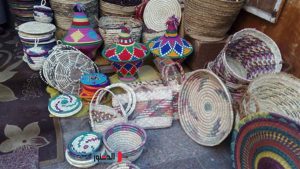
Wool handicrafts
Women in Nuba are famous for making handicrafts that express the heritage and culture of the Nubian society, where women add modern forms in terms of clothing or furnishings that show the culture of women in Nubia.
The tourist market street in Aswan city includes attractive exhibits of handicrafts and traditional arts products that Aswan governorate is famous for, as the handicrafts have a great demand from Egyptians and foreigners. There are also bead products, handmade robes, and accessories of a pharaonic character, And the handmade cap, the Nubian shawl, and Bakkar suit, whether for boys or girls, Beads products, all of which are handcrafted products, and the different types of beaded hats, the Bakkar set, the robes, and the Nubian hat.
He added that it is a sales outlet, but there are specialists in making these handicrafts of Nubian heritage in the villages of western Aswan and the island of Gharb Suhail.

The loom industry
The loom industry is one of the most famous manual activities carried out by the Nuba people, and the loom industry is considered one of the industries that is inherited from father to grandfather, as the loom machine is used to make Nubian shawls, textile, and clothes, and the loom is a manually operated machine and it is one of the machines used by the ancients Egyptians.
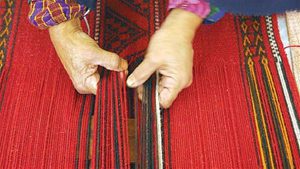
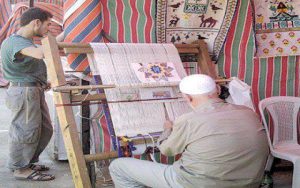
Nubian boats:
In the village of Gharb Suhail on the banks of the Nile, boats are the main means of transportation inside the village, which indicates the importance of the Nile boats inside the village, on which the Nuba people relied thousands of years ago to move to and from the village.
The Nubian boat industry in miniature is also a way to preserve the ancient Nubian heritage, as there are a large number of types of Nubian boats, including “naqoura, qiyasah, felucca, sailboats”, and others, and all of them are used as means of transportation or to transport goods.
Nubian boats are made with some tools such as wood, ropes, colored cardboard and plain paper, as making the unit boat requires great effort and concentration in order to put the smallest details in the boat due to its small size.
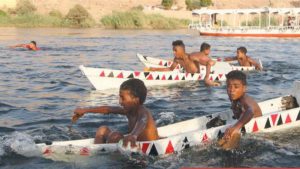
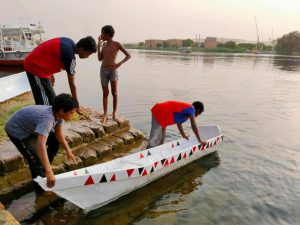

![]()

